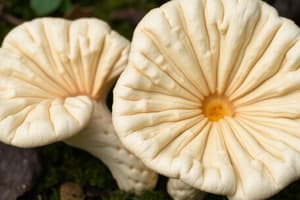Podcast
Questions and Answers
What type of reproduction is commonly seen in basidiomycetes?
What type of reproduction is commonly seen in basidiomycetes?
- Sexual reproduction only
- Reproduction by fragmentation (correct)
- Asexual reproduction only
- Budding and fission
What is the defining characteristic of deuteromycetes?
What is the defining characteristic of deuteromycetes?
- They reproduce exclusively by sexual means.
- They have a highly complex life cycle with multiple stages.
- Only their asexual phases are known. (correct)
- They form large fruiting bodies.
Which of the following structures is produced during sexual reproduction in basidiomycetes?
Which of the following structures is produced during sexual reproduction in basidiomycetes?
- Conidia
- Zygospores
- Sporangia
- Basidia (correct)
What type of mycelium is found in both basidiomycetes and deuteromycetes?
What type of mycelium is found in both basidiomycetes and deuteromycetes?
What important role do many deuteromycetes fulfill in ecosystems?
What important role do many deuteromycetes fulfill in ecosystems?
Flashcards
What are Basidiomycetes?
What are Basidiomycetes?
A group of fungi that includes mushrooms, bracket fungi, and puffballs.
What is a basidiocarp?
What is a basidiocarp?
The fruiting body of a Basidiomycete, where basidia are arranged.
What are Deuteromycetes?
What are Deuteromycetes?
Fungi that reproduce only through asexual spores.
What are conidia?
What are conidia?
Signup and view all the flashcards
What are examples of Deuteromycetes?
What are examples of Deuteromycetes?
Signup and view all the flashcards
Study Notes
Basidiomycetes
- Commonly known as mushrooms, bracket fungi, or puffballs
- Grow in soil, on logs, or tree stumps
- Mycelium is branched and septate
- Asexual spores are not often found
- Reproduction by fragmentation is common
- Plasmogamy brings about fusion of vegetative or somatic cells
- Resultant structure is a dikaryotic
- Karyogamy and meiosis occur in a basidium
- Basidiospores are produced on the basidium
- Basidia are arranged in fruiting bodies called basidiocarps
- Common members include Agaricus (mushroom) , Ustilago (smut), and Puccinia (rust fungus)
Deuteromycetes
- Commonly known as "imperfect fungi"
- Only the asexual or vegetative stages are known
- When the sexual forms are discovered, they are moved to their respective classes.
- Reproduce only via asexual spores, known as conidia
- Mycelium is septate and branched
- Some are saprophytes or parasites
- Many are decomposers
- Examples include Alternaria, Colletotrichum, and Trichoderma
Studying That Suits You
Use AI to generate personalized quizzes and flashcards to suit your learning preferences.
Description
Explore the fascinating world of Basidiomycetes and Deuteromycetes fungi in this quiz. Learn about their reproductive methods, structures, and common examples. Test your knowledge on key characteristics and classifications of these important fungal groups.



